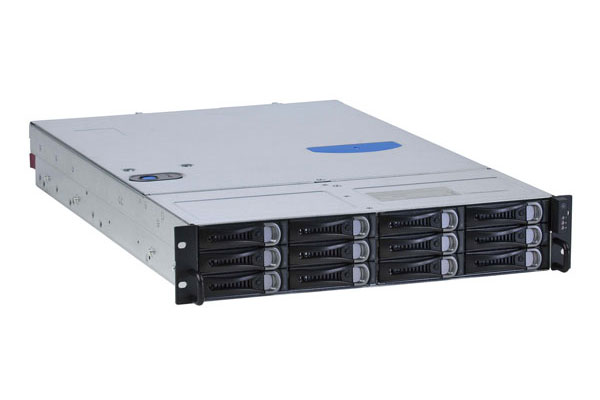Overland Storage REO 4500c

The REO 4500c is a superb choice for D2D data backup and recovery operations. It's offered at a very competitive price and the data compression card increases capacity immensely, but Overland could do much better in the performance stakes.

IP SANs are proving to be a far more cost effective choice for network storage than overpriced FC SANs but the latest REO 4500c from Overland Storage aims to bring together the best of both technologies in a compact appliance based solution.
Overland has been in the IP SAN game right from the start and was one the first to market with an iSCSI storage appliance. The 4500c builds on these successes and delivers a D2D backup and restoration solution that offers virtual disks, tape drives and tape libraries that can be accessed over iSCSI or fibre-channel.
The REO 4500c delivers a good hardware package as this 2U rack system has an Intel SSR212MC2 storage server as its foundation. Overland has built more than a few useful features on top. The appliance is equipped with a dozen 500GB Hitachi SATA hard disks, looked after by an Adaptec SATA/SAS RAID controller. The RAID card also has an external Infiniband connector, enabling up to two 4500 expansion arrays to be added, massively increasing potential capacity.
The drives come preconfigured as a single RAID-5 array with a hot spare, delivering 4.5TB of raw capacity or you can go for a full RAID-5 array without hot-standby. There's more as the 4500c variant on review has the optional data compression feature included, which is handled by a dedicated card that can effectively double storage capacity.
The two embedded Gigabit ports are used for iSCSI target presentation, whilst the LSI dual-port 4Gbps controller handles your fibre channel connections. Although there are plenty of internal fans we did have some concerns about cooling, as during testing the RAID card located near the top of the riser and the lid directly above became quite toasty.
All management access is via a dedicated Ethernet port and the tidy web interface provides easy access to all features. We kicked off with network configuration where you can assign addresses to the Ethernet ports and set up link speed and topology for the FC ports. Where you go next is up to you as you have options for creating VTLs, virtual disks or virtual tape drives.
We started with VTLs and were impressed with the number of options available. You can emulate NEO 2000, 4100 or 4200 libraries and the 4500c offers up to 32 tape drives, 512 available cartridge slots and support for up to six VTL partitions. VTL creation is a cinch as you pick your library type, enter the number of drives and slots, go for automatic bar-code generation and choose the capacity for each virtual tape.
Standalone virtual tape drives and disks are configured differently as you create a volume and then decide what type it should be. You can create up to 64 LUNs for presentation as either a virtual disk, standalone tape drive or as a dynamic tape device, which can have its capacity expanded on the fly. You then declare your iSCSI and FC initiators and assign them to a device ID to grant them access. Note that on the 4500c, hardware data compression for all virtual devices is permanently enabled.
Get the ITPro daily newsletter
Sign up today and you will receive a free copy of our Future Focus 2025 report - the leading guidance on AI, cybersecurity and other IT challenges as per 700+ senior executives
Dave is an IT consultant and freelance journalist specialising in hands-on reviews of computer networking products covering all market sectors from small businesses to enterprises. Founder of Binary Testing Ltd – the UK’s premier independent network testing laboratory - Dave has over 45 years of experience in the IT industry.
Dave has produced many thousands of in-depth business networking product reviews from his lab which have been reproduced globally. Writing for ITPro and its sister title, PC Pro, he covers all areas of business IT infrastructure, including servers, storage, network security, data protection, cloud, infrastructure and services.
-
 Westcon-Comstor and Vectra AI launch brace of new channel initiatives
Westcon-Comstor and Vectra AI launch brace of new channel initiativesNews Westcon-Comstor and Vectra AI have announced the launch of two new channel growth initiatives focused on the managed security service provider (MSSP) space and AWS Marketplace.
By Daniel Todd Published
-
 Third time lucky? Microsoft finally begins roll-out of controversial Recall feature
Third time lucky? Microsoft finally begins roll-out of controversial Recall featureNews The Windows Recall feature has been plagued by setbacks and backlash from security professionals
By Emma Woollacott Published
-
 The UK government wants quantum technology out of the lab and in the hands of enterprises
The UK government wants quantum technology out of the lab and in the hands of enterprisesNews The UK government has unveiled plans to invest £121 million in quantum computing projects in an effort to drive real-world applications and adoption rates.
By Emma Woollacott Published